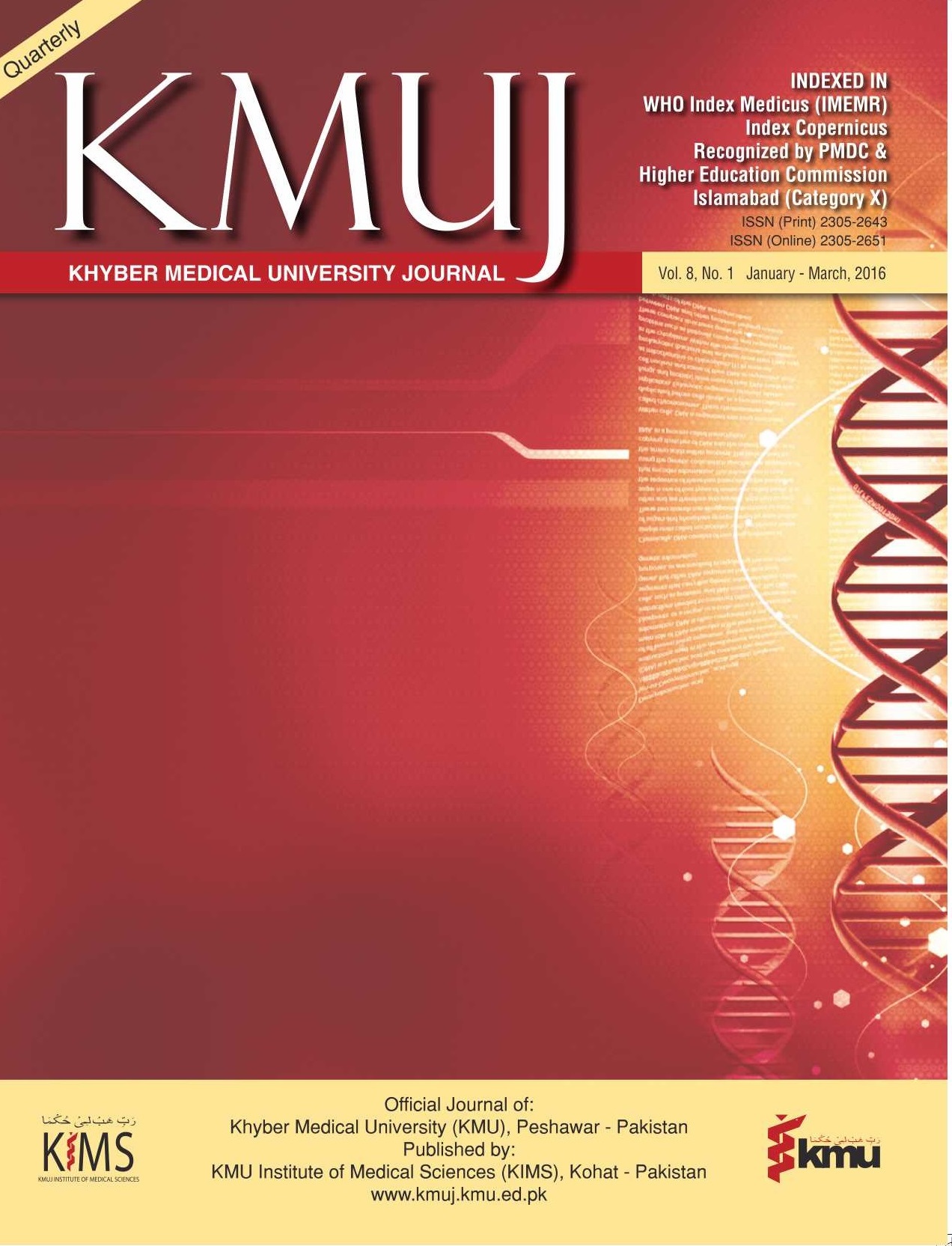ACUTE TOXICITY AND ANALGESIC ACTIVITY OF CRUDE FLAVONOIDS OF ACHILLEA WILHELMSII AND TEUCRIUM STOCKSIANUM
Main Article Content
Abstract
OBJECTIVES: To isolate total flavonoids from Achillea Wilhelmsii and
Teucrium Stocksianum and screen them for possible analgesic activity
and to determine the safe dose range of total flavonoids for preclinical
studies in mice.
METHODS: Acute toxicity studies were performed in mice to determine
its safe dose range for total flavonoids of Achillea wilhelmsii and Teucrium
stocksianum. Writhing tests were performed in mice for possible
analgesic activity. Tail immersion method was used in rats for possible
analgesic activity.
RESULTS: Respective LD50 for crude flavonoids of Achillea wilhelmsii
(CFA) and crude flavonoids of Teucrium stocksianum (CFT) are
1312±12.76 mg/kg and 1248 ±29.6 mg/kg. In acetic acid induced
writhing, analgesic effect of CFA and CFT in dose 10 mg/kg is almost
comparable with standard acetylsalicylic acid (p≤0.05). Similarly, in tail
immersion method, reaction time was significantly prolonged in test
doses of 5 and 10 mg/kg (both for CFA and CFT) suggesting supraspinal
analgesic effect.
CONCLUSION: The results confirm that total crude flavonoids of both
the species, which are safe up to dose of 100 mg/kg, have analgesic
activity. It further warrants for isolation and purification of analgesic
flavonoids for new drug development.
KEY WORDS: Achillea (MeSH), Achillea wilhelmsii (Non-MeSH); Teucrium
stocksianum (Non-MeSH); flavonoids (MeSH), crude flavonoids
(Non-MeSH); Analgesics (MeSH).
Article Details
Work published in KMUJ is licensed under a
Creative Commons Attribution 4.0 License
Authors are permitted and encouraged to post their work online (e.g., in institutional repositories or on their website) prior to and during the submission process, as it can lead to productive exchanges, as well as earlier and greater citation of published work.
(e.g., in institutional repositories or on their website) prior to and during the submission process, as it can lead to productive exchanges, as well as earlier and greater citation of published work.
References
Cushnie TPT, Lamb AJ. Antimicrobial ac¬tivity of flavonoids. Int J Antimicrob Agents 2005;26:343-356.
Peterson J, Dwyer J. Flavonoids: dietary occurrence and biochemical activity. Nu¬trition Research 1998;18(12):1995-2018.
Fernández SP, Wasowski C, Loscalzo LM, Granger RE, Johnston GA, Paladini AC, et al. Central nervous system depressant action of flavonoid glycosides. Eur J Phar¬macol 2006;539(3):168-76.
Bors W, Heller W, Michel C, Saran M. Flavonoids as antioxidants: determination of radical-scavenging efficiencies. Methods Enzymol 1990;186:343.
Sahreen S, Khan MR, Khan RA, Shah NA. Estimation of flavoniods, antimicrobial, an¬titumor and anticancer activity of Carissa opaca fruits. BMC complementary and alternative medicine. 2013;13:372.
Narayana KR, Reddy MS, Chaluvadi M, Krishna D. Bioflavonoids classification, pharmacological, biochemical effects and therapeutic potential. Indian J Pharmacol 2001;33(1):2-16.
Zhang HY, Yang DP, Tang GY. Multipotent antioxidants: from screening to design. Drug Discov Today 2006;11(15):749-54.
Gross M. Flavonoids and cardiovascular disease. Pharm Biol 2004;42(s1):21-35.
Moon YJ, Wang X, Morris ME. Dietary flavonoids: effects on xenobiotic and carcinogen metabolism. Toxicol In Vitro 2006;20(2):187-210.
Asres K, Seyoum A, Veeresham C, Bucar F, Gibbons S. Naturally derived anti-HIV agents. Phytother Res 2005;19(7):557-81.
Kim HP, Son KH, Chang HW, Kang SS. Anti-inflammatory plant flavonoids and cellular action mechanisms. J Pharmacol Sci 2004;96(3):229-45.
Benavente-García O, Castillo J, Marin FR, Ortuño A, Del Río JA. Uses and properties of citrus flavonoids. J Agric Food Chem 1997;45(12):4505-15.
Parveen Z, Deng Y, Saeed MK, Dai R, Ahamad W, Yu YH. Antiinflammatory and analgesic activities of Thesium chinense Turcz extracts and its major flavonoids, kaempferol and kaempferol-3-O-gluco¬side. Yakugaku Zasshi 2007;127(8):1275-9.
Wightman JD, Red berries and their health benefits in Nutraceutical Beverages: Chemistry, Nutrition, and Health Effects (ACS Symp. Ser. 871) 2004;123-132.
Middleton Jr E, Kandaswami C. Effects of flavonoids on immune and inflamma¬tory cell functions. Biochem Pharmacol 1992;43(6):1167-79.
Yamaguchi F, Saito M, Ariga T, Yoshimura Y, Nakazawa H. Free radical scavenging activity and antiulcer activity of garcinol from Garcinia indica fruit rind. J Agric Food Chem 2000;48(6):2320-5.
Kawasaki M, Toyoda M, Teshima R, Sawada J-i, Hayashi T, Arisawa M, et al. In vitro an¬tiallergic activity of flavonoids in histamine release assay using rat basophilic leukemia (RBL-2H3) cells. Shokuhin eiseigaku zasshi. Journal of the Food Hygienic Society of Japan 1994;35(5):497-503.
Sannigrahi S, Mazumder UK, Pal D, Mishra ML, Maity S. Flavonoids of Enhydra Fluc¬tuans exhibits analgesic and anti-inflam¬matory activity in different animal models. Pak J Pharmaceut Sci 2011;24(3):369-75.
Botta B, Vitali A, Menendez P, Misiti D, Delle Monache G. Prenylated flavonoids: pharmacology and biotechnology. Cur Medicinal Chem 2005;12(6):717-39.
Ali N, Shah SW, Ahmed G, Shah I, Shoaib M, Junaid M, et al. Acute toxicity and antispasmodic activities of Achillea wil¬helmsii C. Koch. Pak J Pharmaceut Sci 2014;27(2):309-15.
Shah SM, Sadiq A, Ullah F. Antioxidant, total phenolic contents and antinocicep¬tive potential of Teucrium stocksianum methanolic extract in different animal models. BMC Complement Altern Med 2014;14:181.
Ali N, Ali Shah SW. Antispasmodic activity of Teucrium stocksianum Boiss. Pak J Phar¬maceut Sci 2011;24(2):171-4.
Rasheed RA, Ali BH, Bashir AK. Effect of Teucrium stocksianum on paracetamol-in¬duced hepatotoxicity in mice. Gen Phar¬macol 1995;26(2):297-301.
Ali N, Shah SW, Shah I, Ahmed G, Ghias M, Khan I. Cytotoxic and anthelmintic potential of crude saponins isolated from Achillea Wilhelmsii C. Koch and Teucrium Stocksianum boiss. BMC Complement Altern Med 2011;11:106.
Andersen OM, Markham KR. Flavonoids: chemistry, biochemistry and applications: CRC Press; 2010.
Lu W, Yang Y, Li Q, Liu F. Crude flavonoids from Carya cathayensis Sargent inhibited HeLa cells proliferation through induction of apoptosis and cell cycle arrest. Lat Am J Pharm 2009;28(4):568-73.
Lorke D. A new approach to practi¬cal acute toxicity testing. Arch Toxicol 1983;54(4):275-87.
Hunskaar S, Hole K. The formalin test in mice-dissociation between inflamma¬tory and non- inflammatory pain. Pain 1997;30(7):103-14.
Duarte ID, Nakamura M, Ferreira SH. Participation of the sympathetic system in acetic acid-induced writhing in mice. Braz J Med Biol Res. 1988;21(2):341-3.
Mbiantcha M, Kamanyi A, Teponno RB, Ta¬pondjou AL, Watcho P, Nguelefack TB. An¬algesic and Anti-Inflammatory Properties of Extracts from the Bulbils of Dioscorea bulbifera L. var sativa (Dioscoreaceae) in Mice and Rats. Evid Based Complement Alternat Med: eCAM.2011;2011.
Muhammad N, Saeed M, Khan H. Anti¬pyretic, analgesic and anti-inflammatory activity of Viola betonicifolia whole plant. B
